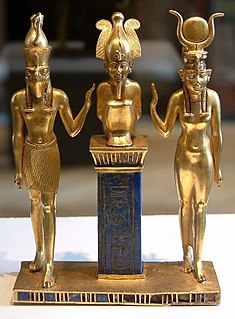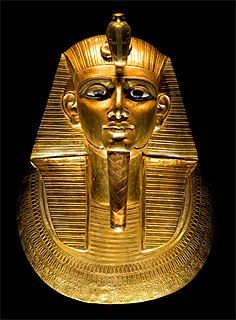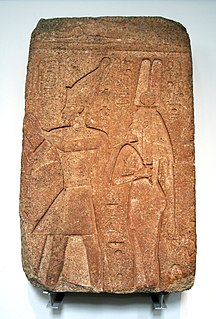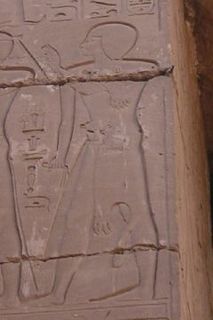
Menkheperre, son of Pharaoh Pinedjem I by wife Duathathor-Henuttawy, was the High Priest of Amun at Thebes in Ancient Egypt from 1045 BC to 992 BC and de facto ruler of the south of the country.

Hedjkheperre Setepenre Takelot II Si-Ese was a pharaoh of the Twenty-third Dynasty of Ancient Egypt in Middle and Upper Egypt. He has been identified as the High Priest of Amun Takelot F, son of the High Priest of Amun Nimlot C at Thebes and, thus, the son of Nimlot C and grandson of king Osorkon II according to the latest academic research. Based on two lunar dates belonging to Takelot II, this Upper Egyptian pharaoh is today believed to have ascended to the throne of a divided Egypt in either 845 BC or 834 BC. Most Egyptologists today, including Aidan Dodson, Gerard Broekman, Jürgen von Beckerath, M.A. Leahy and Karl Jansen-Winkeln, also accept David Aston's hypothesis that Shoshenq III was Osorkon II's actual successor at Tanis, rather than Takelot II. As Aidan Dodson and Dyan Hilton write in their comprehensive book on the royal families of Ancient Egypt:
Takelot II is likely to have been identical with the High Priest Takelot F, who is stated in [the] Karnak inscriptions to have been a son of Nimlot C, and whose likely period of office falls neatly just before Takelot II's appearance.

Usermaatre Setepenamun Osorkon II was the fifth pharaoh of the Twenty-second Dynasty of Ancient Egypt and the son of Takelot I and Queen Kapes. He ruled Egypt around 872 BC to 837 BC from Tanis, the capital of this Dynasty.

Hedjkheperre Setepenre Takelot I was an ancient Libyan ruler who was pharaoh during the Twenty-second Dynasty of Egypt.

Psusennes I was the third pharaoh of the 21st Dynasty who ruled from Tanis between 1047–1001 BC. Psusennes is the Greek version of his original name Pasibkhanu or Pasebakhaenniut, which means "The Star Appearing in the City" while his throne name, Akheperre Setepenamun, translates as "Great are the Manifestations of Ra, chosen of Amun." He was the son of Pinedjem I and Henuttawy, Ramesses XI's daughter by Tentamun. He married his sister Mutnedjmet.

Heqakheperre Shoshenq II or Shoshenq IIa was a pharaoh of the 22nd dynasty of Egypt. He was the only ruler of this Dynasty whose tomb was not plundered by tomb robbers. His final resting place was discovered within an antechamber of Psusennes I's tomb at Tanis by Pierre Montet in 1939. Montet removed the coffin lid of Shoshenq II on March 20, 1939, in the presence of king Farouk of Egypt himself. It proved to contain a large number of jewel-encrusted bracelets and pectorals, along with a beautiful hawkheaded silver coffin and a gold funerary mask. The gold facemask had been placed upon the head of the king. Montet later discovered the intact tombs of two Dynasty 21 kings—Psusennes I and Amenemope a year later in February and April 1940 respectively. Shoshenq II's prenomen, Heqakheperre Setepenre, means "The manifestation of Ra rules, the chosen one of Ra."

Harsiese B was a High Priest of Amun in 874 BC. Earlier Egyptologists assumed he was both the High Priest of Amun (HPA) and son of the High Priest Shoshenq C, who may have become a king at Thebes. However, recent research by Karl Jansen-Winkeln shows that all the monuments of the first (King) Harsiese A demonstrate that he was never Theban High Priest of Amun in his own right, merely a regular Priest of Amun. While the earlier Harsiese was certainly a king at Thebes, he is clearly a different person from the later Harsiese, Harsiese B, who is attested as a High Priest of Amun. Jansen-Winkeln further shows that Harsiese A's son, [...du], was only an ordinary Priest of Amun.

Usermaatre Amenemope was an ancient Egyptian pharaoh of the 21st Dynasty.

King Hedjkheperre Setepenamun Harsiese or Harsiese A, is viewed by the Egyptologist Kenneth Kitchen in his Third Intermediate Period in Egypt to be both a High Priest of Amun and the son of the High Priest of Amun, Shoshenq C. The archaeological evidence does suggest that he was indeed Shoshenq C's son. However, recent published studies by the German Egyptologist Karl Jansen-Winkeln in JEA 81 (1995) have demonstrated that all the monuments of the first (king) Harsiese show that he was never a High Priest of Amun in his own right. Rather both Harsiese A and his son [...du] —whose existence is known from inscriptions on the latter's funerary objects at Coptos —are only attested as Ordinary Priests of Amun. Instead, while Harsiese A was certainly an independent king at Thebes during the first decade of Osorkon II's kingship, he was a different person from a second person who was also called Harsiese: Harsiese B. Harsiese B was the genuine High Priest of Amun who is attested in office late in Osorkon II's reign, in the regnal year 6 of Shoshenq III and in regnal years 18 and 19 of Pedubast I, according to Jansen-Winkeln.

Pedubastis I or Pedubast I was an Upper Egyptian Pharaoh of Ancient Egypt during the 9th century BC. Based on lunar dates which are known to belong to the reign of his rival in Upper Egypt Takelot II and the fact that Pedubast I first appeared as a local king at Thebes around Year 11 of Takelot II's rule, Pedubast I is today believed to have had his accession date in either 835 BC or 824 BC. This local Pharaoh is recorded as being of Libyan ancestry and ruled Egypt for 25 years according to the redaction of Manetho done by Eusebius. He first became king at Thebes in Year 8 of Shoshenq III and his highest dated Year is his 23rd Year according to Nile Level Text No. 29. This year is equivalent to Year 31 of Shoshenq III of the Tanis based 22nd Dynasty of Egypt; however, since Shoshenq II only controlled Lower Egypt in Memphis and the Delta region, Pedubast and Shoshenq III were not political rivals and may even have established a relationship. Indeed, Shoshenq III's son, the general and army leader Pashedbast B "built a vestibule door to Pylon X at Karnak, and in one and the same commemorative text thereon named his father as [king] Sheshonq (III)" but dated his actions here to Pedubast I. This may show some tacit support for the Pedubast faction by the Tanite based 22nd dynasty king Shoshenq III.

Shoshenq C was the eldest son of the 22nd Dynasty pharaoh Osorkon I and queen Maatkare, the daughter of Psusennes II, and served as the High Priest of Amun at Thebes during his father's reign. Consequently, he was the most important official in Upper Egypt after the king himself. He has generally been equated with Heqakheperre Shoshenq II by the English Egyptologist Kenneth Kitchen and viewed as a short-lived co-regent to his father based on the Nile God British Museum statue 8 which identifies him as the son of Osorkon I and Queen Maatkare, daughter of Hor-Psusennes but this assumption is unproven. In the statue, Shoshenq C is called "the Master of the Two Lands" and the formula "beloved of Amun" is enclosed within a royal cartouche. However, in the text of the statue, he is not given a specific throne name or prenomen, the use of a cartouche by a royal prince is attested in other periods of Egyptian history such as that of Amenmes, son of Thutmose I, and the documents depicts Shoshenq C as a simple High Priest of Amun on the side of the legs of the Nile God, rather than a king.

Usermaatre Setepenamun Osorkon III Si-Ese was Pharaoh of Egypt in the 8th Century BC. He is the same person as the Crown Prince and High Priest of Amun Osorkon B, son of Takelot II by his Great Royal Wife Karomama II. Prince Osorkon B is best attested by his Chronicle—which consists of a series of texts documenting his activities at Thebes—on the Bubastite Portal at Karnak. He later reigned as king Osorkon III in Upper Egypt for twenty-eight years after defeating the rival forces of Pedubast I/Shoshenq VI who had apparently resisted the authority of his father here. Osorkon ruled the last five years of his reign in coregency with his son, Takelot III, according to Karnak Nile Level Text No. 13. Osorkon III's formal titulary was long and elaborate: Usermaatre Setepenamun, Osorkon Si-Ese Meryamun, Netjer-Heqa-waset.

Pinedjem II was a High Priest of Amun at Thebes in Ancient Egypt from 990 BC to 969 BC and was the de facto ruler of the south of the country. He was married to his sister Isetemkheb D and also to his niece Nesikhons, the daughter of his brother Smendes II. He succeeded Smendes II, who had a short rule.

Queen Karomama I was an Egyptian queen, married to Osorkon II. She was part of the 22nd dynasty of Ancient Egypt.

The High Priest of Ptah was sometimes referred to as "The Greatest of the Directors of Craftsmanship" (wr-ḫrp-ḥmwt). This title refers to Ptah as the patron god of the craftsmen.

Smendes III was a High Priest of Amun at Thebes during the reign of pharaoh Takelot I of the 22nd Dynasty.

Henuttawy or Henettawy, was an ancient Egyptian princess and priestess during the 21st Dynasty.



























